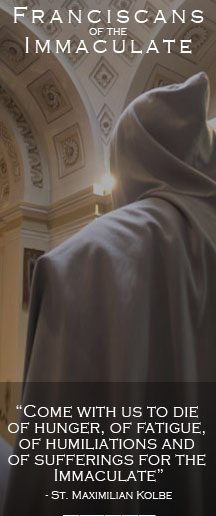The heart of the “City of the Immaculate” was the chapel with the Blessed Sacrament. St. Maximilian introduced Perpetual Eucharistic Adoration at Niepokalanow and assigned turns of adoration to each of the nearly 800 friars. Despite their feverish activity, they regularly adored the Blessed Sacrament with faith and devotion. The fruits were apostolic development, conversions, numerous vocations and the sanctification of the religious.
“Eucharistic Adoration,” St. Maximilian once affirmed, “is the greatest power in the universe, capable of transforming us and changing the face of the world.” His is a definition which catches us off guard, unless we turn immediately to reflect upon the Eucharist as a reality so transcendent, that we will never be able to properly appraise it with our limited powers.
Eucharistic Adoration establishes a personal relationship of faith and love with our divine Redeemer, immolated for each one of us, humbly present as the Host in the tabernacles of our churches. Pope Benedict XVI has reminded us of this with his characteristic style. During his pontificate, he has shown himself to be a totally “Eucharistic” pope.
In his homily of August 21, 2005, at World Youth Day in Germany, the Holy Father explained the importance of Eucharistic Adoration by describing the twofold etymology of the word “adoration.” The Greek word for adoration, proskynesis, “refers to a gesture of submission, the recognition of God as our true measure, whose norm we choose to follow.” The Latin adoratio signifies “mouth to mouth contact, a kiss, an embrace, and hence, ultimately love. Submission becomes union, because he to whom we submit is Love.” This is why, the Holy Father continues, “the Eucharist must become the center of our lives,” just as it was the center of the lives of the saints.
It is written of St. Francis of Assisi that he “was enrapt in adoration of Christ, who was crucified by love, mystically immolated in every Eucharist. He [St. Francis] was pierced to the soul [by contemplation of this love], and so he desired to suffer any affliction that would bring him closer to Christ.” The same Saint addresses this impassioned plea to us: “I implore you, brothers, kissing your feet and with the charity of which I am capable, to show all reverence and all honor possible to the Most Holy Body and Blood of our Lord Jesus Christ” (Letter to a Chapter). This is the mandate of the Seraphic Father, handed on to us as a legacy of fervent love.
What, then, must our life of Eucharistic Adoration be like? The mandate of St. Francis calls us to undertake a serious commitment to Eucharistic Adoration, motivated by an uncommon, extraordinary love. It is a call to that “greater love” spoken of in the Gospel (cf. Jn 15:13), to a self-immolating, crucifying love. It is a call to an adoring love, giving birth to a desire “to suffer any affliction that would bring [one] closer to Christ.”
Was not, then, the Eucharistic Adoration of St. Francis and of St. Clare, his “little plant,” one that obliged them to sacrifice-an adoration that was long and constant, day and night, during night watches and through tears? Theirs was an adoration that sometimes lasted for hours at a time, and at other times consisted in brief visits to the holy tabernacle. More often yet, it took the form of ardent desires and longings.
We know from the life of St. Maximilian that Perpetual Eucharistic Adoration was one of his principal aspirations and preoccupations for the “Cities of the Immaculate” in Poland and Japan. For him, Eucharistic Adoration comprised the “most important work area in the friary.” He himself did not fail to make visits to the Most Blessed Sacrament, offering the entire visit expressly to Our Lady, sometimes simply uttering the brief invocation “Mary,” because in that way he gave “the greatest joy possible” to Jesus.
With reason it is written that St. Pio of Pietrelcina “could be defined as ‘the ecstatic priest of the Eucharist.’ His life, his thought, his heart had a center: he was a prisoner of love of the tabernacle. He drew his strength from the Eucharist to carry the immense weight of his mission of Simon of Cyrene, ready to carry his cross all the way to Calvary with Jesus.” Who could ever forget the figure of Padre Pio who, day after day, spent whole hours in prayer in sight of the tabernacle and under the maternal gaze of Our Lady of Grace? He did this also by night. For this reason, he could say to his spiritual children, “If you are looking for me, you’ll always find me by the tabernacle, with Jesus.”

